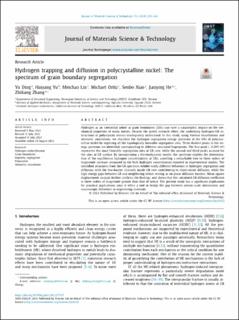| dc.contributor.author | Ding, Yu | |
| dc.contributor.author | Yu, Haiyang | |
| dc.contributor.author | Lin, Meichao | |
| dc.contributor.author | Ortiz, Michael | |
| dc.contributor.author | Xiao, Senbo | |
| dc.contributor.author | He, Jianying | |
| dc.contributor.author | Zhang, Zhiliang | |
| dc.date.accessioned | 2023-09-12T06:06:15Z | |
| dc.date.available | 2023-09-12T06:06:15Z | |
| dc.date.created | 2023-08-25T15:03:18Z | |
| dc.date.issued | 2024 | |
| dc.identifier.citation | Journal of Materials Science & Technology. 2024, 173 225-236. | en_US |
| dc.identifier.issn | 1005-0302 | |
| dc.identifier.uri | https://hdl.handle.net/11250/3088751 | |
| dc.description.abstract | Hydrogen as an interstitial solute at grain boundaries (GBs) can have a catastrophic impact on the mechanical properties of many metals. Despite the global research effort, the underlying hydrogen-GB interactions in polycrystals remain inadequately understood. In this study, using Voronoi tessellations and atomistic simulations, we elucidate the hydrogen segregation energy spectrum at the GBs of polycrystalline nickel by exploring all the topologically favorable segregation sites. Three distinct peaks in the energy spectrum are identified, corresponding to different structural fingerprints. The first peak (-0.205 eV) represents the most favorable segregation sites at GB core, while the second and third peaks account for the sites at GB surface. By incorporating a thermodynamic model, the spectrum enables the determination of the equilibrium hydrogen concentrations at GBs, unveiling a remarkable two to three orders of magnitude increase compared to the bulk hydrogen concentration reported in experimental studies. The identified structures from the GB spectrum exhibit vastly different behaviors in hydrogen segregation and diffusion, with the low-barrier channels inside GB core contributing to short-circuit diffusion, while the high energy gaps between GB and neighboring lattice serving as on-plane diffusion barriers. Mean square displacement analysis further confirms the findings, and shows that the calculated GB diffusion coefficient is three orders of magnitude greater than that of lattice. The present study has a significant implication for practical applications since it offers a tool to bridge the gap between atomic scale interactions and macroscopic behaviors in engineering materials. | en_US |
| dc.language.iso | eng | en_US |
| dc.publisher | Elsevier | en_US |
| dc.rights | Navngivelse 4.0 Internasjonal | * |
| dc.rights.uri | http://creativecommons.org/licenses/by/4.0/deed.no | * |
| dc.title | Hydrogen trapping and diffusion in polycrystalline nickel: the spectrum of grain boundary segregation | en_US |
| dc.title.alternative | Hydrogen trapping and diffusion in polycrystalline nickel: the spectrum of grain boundary segregation | en_US |
| dc.type | Peer reviewed | en_US |
| dc.type | Journal article | en_US |
| dc.description.version | publishedVersion | en_US |
| dc.source.pagenumber | 225-236 | en_US |
| dc.source.volume | 173 | en_US |
| dc.source.journal | Journal of Materials Science & Technology | en_US |
| dc.identifier.doi | 10.1016/j.jmst.2023.07.027 | |
| dc.identifier.cristin | 2169782 | |
| dc.relation.project | Norges forskningsråd: 294689 | en_US |
| dc.relation.project | Sigma2: nn9110k | en_US |
| dc.relation.project | Sigma2: nn9391k | en_US |
| dc.relation.project | Norges forskningsråd: 294739 | en_US |
| cristin.ispublished | true | |
| cristin.fulltext | postprint | |
| cristin.fulltext | original | |
| cristin.qualitycode | 1 | |

